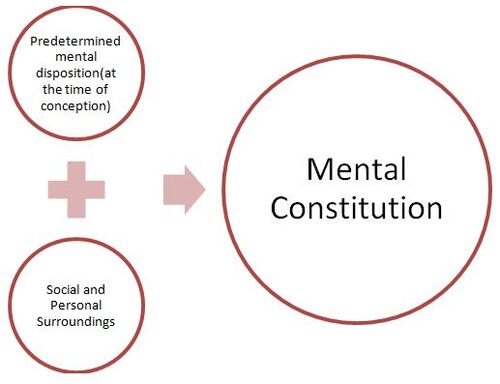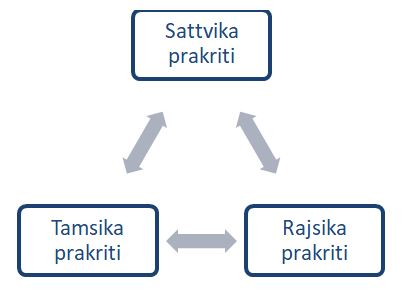Difference between revisions of "Manas prakriti"
| Line 135: | Line 135: | ||
|- | |- | ||
|} | |} | ||
| + | |||
| + | '''Sixteen subtypes of personalities:''' | ||
| + | |||
| + | The three types are classified further into sixteen subtypes based on the development of perfection from the point of darkness. [Cha.Sa.[[Sharira sthana]] 4/37-39][Su.Sa.Sharira Sthana 4/81-97]<ref name=Susruta/> Kashyapa added two more to bring the total to eighteen. [Ka.Sa.Sutra Sthana 28/8-31]<ref name=Kashyapa> Kashyapa. Kashyapa Samhita. Edited by P. V. Tewari. Reprint. Varanasi: Chaukhambha vishvabharati;2008.</ref> Individuals are placed into one of these groups depending on their psychological development, which is arranged in a highly methodical sequence (order of development from [[tama]] to [[sattva]]). Individuals categorized under brahma kaya (traits of supreme God Brahma) have the highest level of mental characteristics. Individuals with vanaspatya (traits of vegetable life), which is at the bottom of the list of development phases have a lower level of mental faculties. This systemic pattern depicts the evolution process from vanasptya to brahma, demonstrating the inclination in terms of mental traits. Here, the first three [[prakriti]] classifications are further subdivided into subtypes based on variants arising from the natural interaction of the traits of each core group. Most of the subtypes have some common features with the upper one and lower one subtype which shows the possibility of inclination from one stage to another in terms of psychological development. This nomenclature is primarily based on the systematic development of psychological faculties.<ref name=Shreevathsa>Shreevathsa, Rambabu Dwivedi. Manasaprakriti(personality in Ayurveda). First edition. Varanasi: Chaukhambhavisvabharati; 2011.</ref> | ||
| + | |||
| + | [[File: Developmental_phases_of_manasa_prakriti.JPG|500px|'''Image 3: Developmental phases of manasika prakriti'''|thumb]] | ||
| + | |||
| + | Characteristics features of each of the following subtypes are following [Cha.Sa.[[Sharira Sthana]] 4/37-39]: | ||
Revision as of 12:27, 21 January 2022
The psychological constitution of an individual is known as ‘manasika prakriti’. In terms of thoughts, motivation, response, intellect, logic, and emotion, it is the sum total of features and patterns that influence the personal and social conduct of the individual. In Ayurveda, the role of mental constitution in the treatment of ailments is widely recognized. Ayurveda explains mental dosha, psychological constitutions and classification of mental disorders distinctly. This is helpful in determining predisposition and vulnerability to stressors and their consequences. This drives the person to think, feel, and act in certain ways; and makes each person unique.
| Section/Chapter/topic | Concepts/Prakriti/Manas prakriti |
|---|---|
| Authors | Bojani M. K. 1, Tanwar A. K. 2 |
| Reviewers | Basisht G.3, |
| Editors | Deole Y.S.3 Basisht G.3 |
| Affiliations |
1 Department of Sharir Kriya, All India Institute of Ayurveda, New Delhi 2 Department of Kriya Sharira, All India Institute of Ayurveda, New Delhi 3 Charak Samhita Research, Training and Development Centre, I.T.R.A., Jamnagar,India |
| Correspondence emails | carakasamhita@gmail.com |
| Date of first publication: | January 20, 2022 |
| DOI | under process |
Etymological derivation
The word ‘manasa prakriti’ is made from two different words, manasa and prakriti. Manasa denotes mind or psyche. Prakriti denotes nature or form or source. Thus, the word ‘Manasa prakriti’ means "natural or original form" or "original source" of individual’s psychological qualities. It forms the psychological constitution.
Synonyms
The psychological constitution is also known as mental disposition, mental temperament, mental constitution, personality, mental trait and psychological rhythm. Manasika prakriti denotes mind's design, psychological makeup of an individual,[1] totality of an individual's reactions and interactions with others, influencing factors behind personal morals, perceptions, values, and attitudes.
Formation and development
Prakriti is formed during conception by union of sperm (shukra) and ovum (shonita) with consciousness elements (atmavikara).[Su.Sa. Sharira Sthana 4/63][2] Manasa prakriti is formed at the same moment by combination of three primary attributes (trigunatmaka)(Code: SAT-A.126).[3]This forms the fundamental structure of psychological constitution. The hereditary components, social surroundings, personal factors like diet, experiences, and cultural background determine the development of psychological constitution further.
Changeable nature
The qualities (guna) are constantly influenced by above mentioned factors. Thus, the psychological constitution may change relatively to the influence of surrounding factors and experiences. It may shift from tamas dominance to rajas dominance or sattva dominance and vice versa. There is always a predominance of activity of one attribute over another. This dominance influences and determines the individual's personality. A person's mind appears different in different situations owing to differences in perception and connections with purity (sattva), passion (rajas), and ignorance (tamas)(Code: SAT-A.127-129)[3][Chakrapani on Cha.Sa.Sharira Sthana 3/13][Chakrapani on Cha.Sa.Sutra Sthana 8/5]. The mental disposition is ultimately determined by the frequency of predominance.[Cha.Sa.Sutra Sthana 8/6]
Mental personality is the result of an individual's continuous and inherent development in terms of how they adopt with the situation. A variety of mental characteristics are observed in the behavior pattern that are influenced by the social environment.
Classification
Ayurvedic mental constitution is categorized on the basis of three fundamental attributes (triguna). Accordingly, there are three types viz. shuddha (sattva dominant), rajas dominant, and tamas dominant having respective determining factors (bhaga or ansha). [Cha.Sa.[[Sharira Sthana 4/36] The three factors are welfare tendency or auspiciousness (kalyanansha), anger or passion tendency (roshansha), and perplexity or bewilderment (mohansha). This makes the constitution dynamic. The following table shows the characteristics of these three personalities. [Su.Sa.Sharira Sthana 1/98][2]
| S.No. | Type of Mental constitution | Qualities |
|---|---|---|
| 1 | Sattvika(Code: VE-1)[3] | Kindness (anrushasyam) |
| Tendency of sharing belongings (samvibhagaruchita) | ||
| Forgiveness (titiksha) | ||
| Truthfulness (satya) | ||
| Religiousness (dharma) | ||
| Believing in God or veda (astikyam) or optimism | ||
| Knowledgeable (gyana) | ||
| Logical intelligence (buddhi) | ||
| Good memory(smriti) | ||
| Wisdom (medha) | ||
| Good retention power of the mind (dhriti) | ||
| Non attachment or overindulgence (anabhishanga) | ||
| 2 | Rajasika (Code: VE-2)[3] | Excessive miseries in life (dukkha) |
| Excessive wandering (atanshilata) | ||
| Less retention or impatience (adhriti) | ||
| Ego (ahankar) | ||
| Untruthfulness (anrutikatvam) | ||
| Unkindness (akarunyam) | ||
| Hypocrisy or fraud (dambha) | ||
| Haughtiness or arrogance (mana) | ||
| Pleasure or exhilaration (harsh) | ||
| Lust or excessive indulgence (kama) | ||
| Anger (krodha) | ||
| 3 | Tamasika (Code: VE-3)[3] | Sadness (vishada) |
| Not believing in God and veda (nastikyam) or pessimism | ||
| Not follow the religion or righteousness (adharmashilata) | ||
| Perverted intelligence (buddhenirodho) | ||
| Dumbness (ajnana) | ||
| Foolishness (durmedhastvam) | ||
| Lethargy or inactivity (akarmashilta) | ||
| Sleepiness (nidralu) |
Sixteen subtypes of personalities:
The three types are classified further into sixteen subtypes based on the development of perfection from the point of darkness. [Cha.Sa.Sharira sthana 4/37-39][Su.Sa.Sharira Sthana 4/81-97][2] Kashyapa added two more to bring the total to eighteen. [Ka.Sa.Sutra Sthana 28/8-31][4] Individuals are placed into one of these groups depending on their psychological development, which is arranged in a highly methodical sequence (order of development from tama to sattva). Individuals categorized under brahma kaya (traits of supreme God Brahma) have the highest level of mental characteristics. Individuals with vanaspatya (traits of vegetable life), which is at the bottom of the list of development phases have a lower level of mental faculties. This systemic pattern depicts the evolution process from vanasptya to brahma, demonstrating the inclination in terms of mental traits. Here, the first three prakriti classifications are further subdivided into subtypes based on variants arising from the natural interaction of the traits of each core group. Most of the subtypes have some common features with the upper one and lower one subtype which shows the possibility of inclination from one stage to another in terms of psychological development. This nomenclature is primarily based on the systematic development of psychological faculties.[5]
Characteristics features of each of the following subtypes are following [Cha.Sa.Sharira Sthana 4/37-39]:
- ↑ Available on https://dictionary.apa.org/constitution.
- ↑ 2.0 2.1 2.2 Sushruta. Sushruta Samhita. Edited by Jadavaji Trikamji Aacharya. 8th ed. Varanasi: Chaukhambha Orientalia;2005.
- ↑ 3.0 3.1 3.2 3.3 3.4 National AYUSH Morbidity and Standardized Terminologies Electronic Portal by Ministry of AYUSH Available on http://namstp.ayush.gov.in/#/Ayurveda
- ↑ Kashyapa. Kashyapa Samhita. Edited by P. V. Tewari. Reprint. Varanasi: Chaukhambha vishvabharati;2008.
- ↑ Shreevathsa, Rambabu Dwivedi. Manasaprakriti(personality in Ayurveda). First edition. Varanasi: Chaukhambhavisvabharati; 2011.


